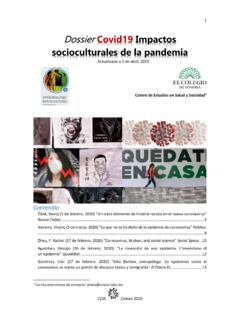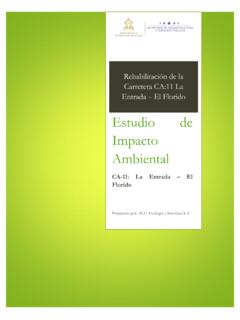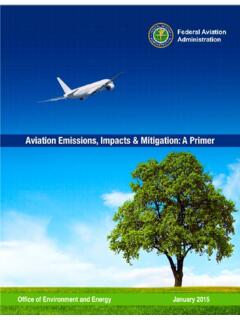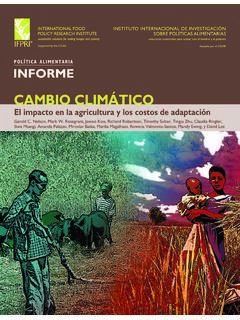Transcription of Food wastage footprint: Impacts on natural resources ...
1 food wastage footprint Impacts on natural resources The designations employed and the presentation of material in this information product do not imply the expression of any opinion whatsoever on the part of the food and Agriculture Organization of the United Nations (FAO) concerning the legal or development status of any country, territory, city or area or of its authorities, or concerning the delimitation of its frontiers or boundaries. The mention of specific companies or products of manufacturers, whether or not these have been patented, does not imply that these have been endorsed or recommended by FAO. in preference to others of a similar nature that are not mentioned. The views expressed in this information product are those of the author(s) and do not necessarily reflect the views or policies of FAO.
2 ISBN 978-92-5-107752-8. FAO 2013. FAO encourages the use, reproduction and dissemination of material in this information product. Except where otherwise indicated, material may be copied, downloaded and printed for private study, research and teaching purposes, or for use in non-commercial products or services, provided that appropriate acknowledgement of FAO as the source and copyright holder is given and that FAO's endorsement of users' views, products or services is not implied in any way. All requests for translation and adaptation rights, and for resale and other commercial use rights should be made via us/licence-request or addressed to FAO information products are available on the FAO website ( ) and can be purchased through publications- About this document The food wastage footprint model (FWF) is a project of the natural resources Management and Environment Department.
3 Phase I of the project has been commissioned to BIO-Intelligence Service, France. This Summary Report presents the preliminary results of the FWF modeling, as related to the Impacts of food loss and waste on climate, land, water and biodiversity. The full technical report of the FWF model is available upon request from FAO. Phase II of the FWF project is expanding the model to include modules on full-cost accounting of environmental and social externalities of food wastage , with also comparison with food wastage reduction investment costs and footprint scenarios for 2050. Acknowledgements Phase I of the FWF was implemented by BIO-IS staff including: Olivier Jan, Cl ment Tostivint, Anne Turb , Cl mentine O'Connor and Perrine Lavelle.
4 This project benefited from the contributions of many FAO experts, including: Alessandro Flammini, Nadia El-Hage Scialabba, Jippe Hoogeveen, Mathilde Iweins, Francesco Tubiello, Livia Peiser and Caterina Batello. This FWF project is undertaken with the generous financial support of Germany. Queries regarding the FWF project must be addressed to: food wastage footprint Impacts on natural resources Table of Contents Executive summary 6. Introduction 8. Context and definitions 8. Scope and methodology 9. food wastage volumes 11. Carbon footprint 16. Water footprint 26. Land use 36. Biodiversity 47. Economic assessment 55. Cross-analysis and key findings 57. Potential improvement areas 59. References 60.
5 List of Figures Figure 1: Sources of food wastage and sources of environmental Impacts in the food life cycle 10. Figure 2: Total agricultural production (FBS) vs. food wastage volumes 12. Figure 3: food wastage volumes, at world level by phase of the food supply chain 13. Figure 4: Relative food wastage , by region and by phase of the food supply chain 13. Figure 5: Top 10 of region*commodity pairs for food wastage 15. Figure 6: Top 10 of region*commodity pairs for food wastage volumes per capita 16. Figure 7: Top 20 of GHG emitting countries vs. food wastage 17. Figure 8: Contribution of each commodity to food wastage and carbon footprint 18. Figure 9: Contribution of each region to food wastage and carbon footprint 20.
6 Figure 10: Contribution of each phase of the food supply chain to food wastage and carbon footprint 21. Figure 11: Carbon footprint of food wastage , by phase of the food supply chain with respective contribution of embedded life-cycle phases 21. Figure 12: Carbon footprint of food wastage , by region and by commodity 23. Figure 13: Carbon footprint of food wastage , by region per capita results 24. Figure 14: Top 10 of region*commodity pairs for carbon footprint presented along with contribution to food wastage volume 24. Figure 15: Top 10 of region*commodity pairs for carbon footprint per capita 26. Figure 16: Top 10 of national blue water footprint accounts for consumption of agricultural products vs.
7 food wastage 28. Figure 17: Contribution of each commodity to food wastage and blue water footprint 29. Figure 18: Contribution of each region to food wastage and blue water footprint 30. Figure 19: Blue water footprint of food wastage , by region and by commodity 31. Figure 20: Blue water footprint of food wastage , by region per capita results 32. Figure 21: Top 10 of region*commodity pairs for blue water footprint presented along with contribution to food wastage volume 33. Figure 22: Top 10 of region*commodity pairs for blue water footprint per capita 35. Figure 23: food wastage vs. surfaces of river basins with high/very high water scarcity 35. Figure 24: Top 20 of world's biggest countries vs.
8 food wastage 37. Figure 25: Contribution of each commodity to food wastage and land occupation 38. Figure 26: Land occupation of food wastage , at world level by commodity arable land vs. non-arable land 39. Figure 27: Contribution of each region to food wastage and land occupation 40. Figure 28: Land occupation of food wastage , at world level by region Arable land vs. non-arable land 41. Figure 29: Land occupation of food wastage , by region and by commodity 43. Figure 30: Top 10 of region*commodity pairs for arable land occupation presented along with contribution to food wastage volume 44. Figure 31: Top 5 of region*commodity pairs for non-arable land occupation presented along with contribution to food wastage volume 45.
9 Figure 32: Top 10 of region*commodity pairs for land occupation per capita 45. Figure 33: Repartition of food wastage at agricultural production stage, by class of land degradation 46. Figure 34: Maximum area of forest converted to agriculture from 1990 to 2010, in regions where deforestation occurred 49. Figure 35: Percentage of Red List species of Birds, Mammals and Amphibians that are threatened by agriculture (both crops and livestock) 50. Figure 36: Percentage of Red List species of Birds, Mammals and Amphibians that are threatened by crop production and livestock farming 51. Figure 37: Average change in mean trophic level since 1950 in selected Large Marine Ecosystems (LMEs). of Europe, NA&Oce and Ind.
10 Asia 53. Figure 38: Average change in mean trophic level since 1950 in selected Large Marine Ecosystems (LMEs). of SSA, NA, WA&CA, S&SE Asia and LA 54. Figure 39: Contribution of each commodity to food wastage and economic cost 56. Figure 40: Contribution of each region to food wastage and economic cost 56. List of Tables Table 1: World regions selected for the FWF project 9. Table 2: Agricultural commodity groups selected for the FWF project 9. Table 3: Cross-analysis of all environmental components, by Region*Commodity pairs 57. Executive summary FAO estimates that each year, approximately one-third of all food produced for human consumption in the world is lost or wasted. This food wastage represents a missed opportunity to improve global food security, but also to mitigate environmental Impacts and resources use from food chains.
















